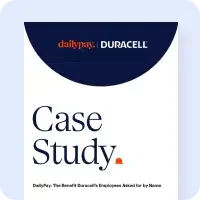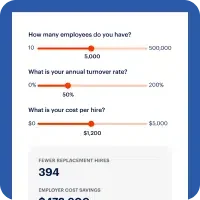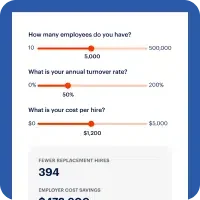In the demanding world of building materials manufacturing, safety isn’t just about hard hats and clear signage—it’s about focusing on overall employee well-being.
For too long, the industry has operated in a reactive mode, focusing on incidents after they happen.
But a true proactive safety culture demands a shift: recognizing that an employee’s well-being is the single most powerful tool for preventing accidents, moving your organization from constant near-misses to a state of zero-harm.
The High-Risk Nature of Building Materials Manufacturing
The environment within building materials production is inherently hazardous. Employees in this sector often perform physically demanding work in an environment where a momentary lapse in concentration can have severe, even fatal, consequences.
In such a high-stakes setting, traditional safety protocols are essential, but they are insufficient on their own.
The greatest danger isn’t a machine malfunction; it’s a human factor—specifically, a distracted or stressed employee whose focus is compromised long before they step onto the production floor.
When Financial Stress Becomes a Safety Risk
While physical hazards are visible, invisible stressors can pose an even greater threat. One of the most significant distractions facing today’s workforce is financial stress.
When an employee is worried about an unexpected bill, a car repair, or a medical emergency, that anxiety doesn’t disappear when they punch in. Instead, it becomes a persistent worry that makes it harder for employees to focus on the task at hand. This distraction can lead to critical errors.
In a high-speed, high-consequence environment like a building materials plant, these small lapses due to financial distraction translate directly into a higher risk of injury. A clear mind is your best safety measure, and financial stress can get in the way.
What the Data Shows About Burnout and Injuries
The stress of demanding work environments and personal pressures leads inevitably to burnout, which is a significant contributor to a compromised safety record.
The link between exhaustion and accidents is quantifiable. In the manufacturing and construction sectors—both proxies for the high-pressure building materials industry—burnout is widespread. A study by the University of Cambridge’s Laing O’Rourke Centre shows that stress affects 70% of workers in the construction industry, which can pose serious risks to physical and mental health. This stress is driven by factors like relentless high workloads, long hours exceeding 50 per week, and a lack of job control—all conditions that actively deplete the mental energy required for safety vigilance. When focus is compromised, the risk of physical injury skyrockets.
According to the Travelers Injury Report (2025), the average number of days missed due to workplace injury in the manufacturing sector has been on the rise. More alarmingly, the report highlights the vulnerability of newer employees, with a significant percentage of all manufacturing injuries occurring to workers in their first year on the job. This high-risk group is particularly susceptible to the effects of unclear expectations and production pressures, accelerating burnout and impairing decision-making precisely when they need to be most attentive.
Furthermore, a look at broader trends in manufacturing reveals that manufacturers are increasingly recognizing the problem, with many executives prioritizing the need to train managers to address and recognize employee burnout. The industry understands that high-pressure environments create chronic stress, and chronic stress directly erodes the necessary vigilance for safety.
The Role of Well-Being in Preventing Accidents
A truly proactive safety program must move beyond compliance checklists and embrace a holistic approach to employee health. This is where comprehensive well-being programs come in.
Well-being encompasses physical, mental, and, crucially, financial health. By investing in benefit programs that holistically support your employees, you’re not just being a good employer—you’re actively mitigating your greatest safety risk.
Holistic well-being programs help by:
- Improving Focus: Reducing the mental load from personal stressors so employees can concentrate on their work.
- Reducing Fatigue: Addressing the root causes of burnout that lead to slower reaction times and poor judgment.
- Boosting Engagement: Making employees feel valued, which increases their adherence to safety protocols and their willingness to speak up about hazards.
On-Demand Pay and Workforce Focus
One powerful, modern tool that directly addresses financial stress and supports employee focus is On-Demand Pay (also known as earned wage access).
On-Demand Pay allows employees to access a portion of their earned pay before their traditional payday. This voluntary benefit offers an immediate solution for navigating financial emergencies. By providing a financial buffer, it prevents an employee from having to worry about a bill while operating heavy machinery.
- In the last year, window and door manufacturing company The Pella Corporation has seen a 28.2% improvement in tenure among DailyPay engaged employees.1
- Andersen Corporation employees have set aside more than $1,000,000 using DailyPay savings features since the partnership began, demonstrating the financial health and stability DailyPay brings to a manufacturing workforce.2
The impact is clear: Internal research shows that 62% of DailyPay users in the manufacturing industry say that DailyPay gives them more time to think of other things in their life besides money.3
A happier, less stressed employee is a more present employee, and in an industry like building materials, presence equals safety. By helping employees achieve greater financial peace of mind, you are directly investing in their on-the-job focus and your safety record.
Moving From Near-Miss to Zero-Harm
The goal of zero-harm is ambitious but achievable. It requires a fundamental shift in mindset—from reacting to accidents to proactively cultivating a safe, healthy, and focused workforce.
For building materials leaders, this means recognizing that employee well-being is not a perk or an HR-only issue; it is a core pillar of operational safety. By implementing tools like On-Demand Pay to alleviate financial stress and by prioritizing a holistic approach that combats burnout, you can empower your team to be their most alert and safest selves.
When employees are supported, they are focused. When they are focused, accidents are prevented. Embrace the role of well-being in proactive safety today to make your commitment to zero-harm a reality.
Ready to learn how integrating a financial wellness platform can improve employee well-being?
1 Internal Data, October 2025:DailyPay, 2020
2 Internal Data, October 2025:DailyPay, 2020
3 DailyPay Employee Experience Research, Arizent study commissioned by DailyPay, September 2023:DailyPay, 2020











